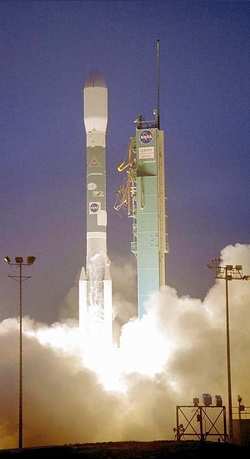Agency Decides To Phase Out Delta II Over Monetary
Concerns
 The National Aeronautic
and Space Administration decided to phase out its use of Delta II
launch vehicles in favor of Evolved Expendable Launch Vehicle
(EELV) program's Delta IV and Atlas V.
The National Aeronautic
and Space Administration decided to phase out its use of Delta II
launch vehicles in favor of Evolved Expendable Launch Vehicle
(EELV) program's Delta IV and Atlas V.
Bill Wrobel, NASA's assistant associate administrator for launch
services, said the decision ultimately came down to money,
according to Space.com. The cost of a Delta II launch is already
rising and is expected to keep rising past its current $65 million
per-launch mark, when the US Air Force stops using the Delta II
altogether in favor of the Atlas V and Delta IV.
"The Air Force is basically going full steam ahead with EELVs,"
Wrobel said. "And since they are a user of (the EELV rockets) we
thought maybe we should become more of a user of it too."
Wrobel wouldn't talk about specific costs for Delta II launches,
but told Space News NASA conducted an internal study last month
that concluded EELV usage would be more cost effective in the long
run for its medium-lift launch needs after 2010.
"It turns out in the future, if you were to wrap everything up
-- and I'm talking about launch site infrastructure, restarting the
line, the basic cost of the vehicles, etc. ... it really isn't more
expensive" to use EELVs, he said. "That's part of what we were
facing and what this really gets down to. As with anybody else,
it's all about money ... That's where we all came to the decision
that it made more sense for us to go down the EELV road in the
future."
The final Delta 2 launch is scheduled around the end of this
decade. The current scheduled launch is the Dawn spacecraft in
September, to investigate two large protoplanets in the main
asteroid belt, Vesta and Ceres.
The current contract has nine remaining Delta II launches,
including Dawn. The last one is scheduled for November 2009 -- of
the Wide-field Infrared Survey Explorer (WISE) spacecraft.
NASA is still responsible for a tenth Delta II launch, already
in production, that has yet to be assigned a payload. If NASA
abandons it, the agency would be liable to United Launch Alliance
for a very large termination fee. Wrobel wouldn't say how much,
though.
"Let me put it this way, we are going to work pretty hard to try
to find a home for it," he said.
Mike Rein, spokesperson for the Denver-based United Launch
Alliance (ULA), a joint venture that combines the Delta and Atlas
rocket programs of Boeing and Lockheed Martin, confirmed the
agency's decision to stop using Delta II once the current launch
services contract expires. The company will continue to not only
market Delta II launches to US government customers; it will also
continue support for Boeing Launch Services' commercial Delta II
sales through 2012.
"ULA understands the combination of a reduction in the demand
for launches from the NASA science community and the conclusion of
the [US Air Force] contract for GPS Delta II launches has made it
difficult for NASA to justify the business case for continuing
Delta II support beyond currently contracted missions," Rein said
in a written statement. "ULA is required by our current NASA Launch
Services contract with NASA to offer Delta II launches through
launch year 2012."
The decision supports a 2005 agreement between NASA and the Air
Force for the space agency to make greater use of the EELV rockets.
The Air Force, in turn, endorsed NASA's decision to build new
shuttle-derived launchers instead of upgrading EELVs.
Wrobel also said NASA hasn't ruled out directing some or even
all of its future medium-class missions to new providers.
"We wouldn't preclude using them in the future if they become
available," he said.
To see who had what to offer in that arena, NASA issued a
request for information August 7. Wrobel said this is also an
opportunity for the agency to receive suggestions as to how it can
improve its qualifying processes for new launch service
providers.
Two such companies are Orbital Sciences Corp. of Dulles, VA
which has begun development of a Delta 2-class launcher, the Taurus
2. Space Exploration Technologies, based in El Segundo, CA, is
scheduled to debut its Falcon 9 rocket that could also carry Delta
II-class payloads.

"We will continue to talk to NASA about some ideas we have for a
Delta II-class launch vehicle that is conceived to be significantly
less in terms of cost than the current Delta 2 design," said
Orbital Sciences spokesman Barron Beneski.
 ANN's Daily Aero-Term (04.20.24): Light Gun
ANN's Daily Aero-Term (04.20.24): Light Gun Aero-News: Quote of the Day (04.20.24)
Aero-News: Quote of the Day (04.20.24) ANN's Daily Aero-Linx (04.21.24)
ANN's Daily Aero-Linx (04.21.24) Aero-News: Quote of the Day (04.21.24)
Aero-News: Quote of the Day (04.21.24) ANN's Daily Aero-Term (04.21.24): Aircraft Conflict
ANN's Daily Aero-Term (04.21.24): Aircraft Conflict




